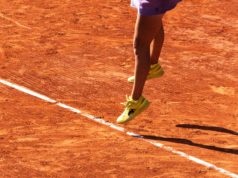By Lee Myers, UGA Women’s Head Coach 1980-84, STA female player of the year 2000, North Springs HS coach 2007-2020, freelance writer and ALTA coach
Think you’re ready for Spring ALTA? Racquet restrung? Check. Team practices underway and first lineup settled? Double check. But are you ready for the competition, for some adversity, perhaps even confrontation? You know that the score in match number one could get tight, and at some point as the first set nears its end or a tiebreaker looms, you know there could be a line call issue, score dispute, or worse yet — a rules disagreement.
So let’s try again: Are you ready for Spring ALTA? Once you enter the ALTA house, you better be on your toes and rules-ready. Having confidence in your knowledge of the rules that guide play and rein in your court, make you a more self-assured player. Just like marching through a breaker knowing exactly whose turn it is to serve, when to switch ends, and who starts serving the next set, when you are well versed in the rules of the court, you are just a more complete and competent player.
Of course, you do want to compete in the spirit of fair play, maintaining a code of etiquette at all times. But there is no substitution for knowing this game’s rules and The Code that guides them. Unlike most other sports, tennis played recreationally has no set of officials on court making calls or awarding points. ALTA is DIY officiating! You monitor yourself and your own matches using the same set of regulations adhered to by ATP and WTA playing professionals and umpires, as well as using The Code. The Code is the section of tennis rules that guides how the game should be played, ensuring fair-mindedness and consideration of opponents, other players, and the courts themselves.
The Rules of Tennis delineates the set-up and playing of the game. It describes proper court dimensions, ball pressure, how to keep score, when players should change ends, et cetera. The Code, however, digs a little deeper into the what-if’s of things such as lets, double bounces, and delays-of-game — the things which when handled improperly can amount to poor sportsmanship or actual cheating.
Familiarize yourself with The Code and all rules of the court. Print out a copy; keep it in your tennis bag. As matches move along, take the time to learn a few new rules and add to your arsenal each week of the ALTA season. By playoffs, you will be umpire material! Just keep in mind that you’re not actually an umpire and don’t have the right to become one during a match. On court, think like an ump, but try not to act like one. Know your ALTA House rules!
Here’s a Top Ten list of commonly misunderstood rules and etiquette and where to find the actual ruling in the Friend at Court tennis booklet.
TOP TEN Commonly Misunderstood Rules
Winning the toss
- The player/team who wins the toss may choose one of three things to start the match (1) to be the server or receiver in game one OR (2) to start the match at one end of the court or the other OR (3) to require the opponent to choose ONE of the other choices.
- Both players/teams have the right to new choices if the warm-up is stopped and players leave the court. However, the result of the original toss stands despite any delay [see Rules of Tennis – Choice of Ends & Service #9a-c, page 8]
Player loses point
- If the receiver returns the serve before it bounces,
- If the player hits the ball before it has passed the net,
- If the ball in play touches the player or anything the player is wearing or carrying except the racquet,
- If a player standing outside the court hits the ball foul or catches it before it bounces and claims the point because the ball was definitely going out of the correct court [see Rules – Player Loses Point #24, e, h, i, Case 8, pages 11-12].
Ball in play
- It is a good return when the ball in play has hit the ground within the correct court and then has spun or been blown back over the net; the player is permitted to reach over without touching the net to play the ball into the correct court.
- It is a good return if the ball is returned outside the net posts, either above or below the level of the top of the net, even though it touches the net posts [see Rules – A Good Return #25 b, c. page 12].
Correcting errors
- As a principle, when an error is discovered, all points previously played shall stand.
- Serve: during a game or tie-break game, if a server serves from the wrong half of the court, this should be corrected immediately and include any faults served, and the server shall serve from the correct half of the court according to the score.
- Server: if a player serves out of turn, the correct server begins to serve immediately; if the game was completed, the order of service remains as altered; if the error occurs during a tie-breaker and an even number of points has been played, the correction is immediate; if an odd number of points has been played, the service order remains as altered.
- Receiver: when an error is discovered in receiving order during a game or tie-breaker, the order remains as altered for the rest of that game then receiving sides resume the original order.
- Court ends: during a game or breaker, if players are at the wrong ends of the court, the error should be corrected immediately [see Rules – Correcting Errors #27 a-e. pages 13-14].
Reversing calls & partner disagreement on calls
- A player who calls a ball out shall reverse the call if uncertain or realizes the ball was good; the point is NOT replayed.
- If one partner calls the ball out and the other partner calls the ball good, the ball is good; the point is NOT replayed [see CODE – Making Calls #12, #14. page 38].
Self-calls — double bounce, double hit, reaching over net, touching net
- A player shall concede the point when a ball is in play and touches that player; or that player or racquet touches the net or the opponent’s court; or that player hits the ball before it crosses the net; or that player deliberately carries or hits the ball twice; or a ball bounces more than once in that player’s court.
- Each of these are calls that must be made on yourself or your partner. The opponent is NOT entitled to make any of these calls [see Code – Making Calls #19. page 38].
Delays during service
- The time it takes to clear a ball between first and second serves is not considered sufficient time to warrant two serves. The receiver, not the server, is the judge of whether the delay is sufficiently prolonged to justify giving the server two serves. [see Code – Serving #30. page 39].
Talking during play
- If a player hits a weak lob and yells “get back,” and the yell distracts an opponent about to hit the ball, then the opponent may claim the point based on a deliberate hindrance [see Code – Hindrance Issues #34. page 40].
Calling lets — hindrances unintentional and intentional
- A player hindered by an opponent’s unintentional act or something outside the player’s control is entitled to a let only if the player could have made the shot had the player not been hindered; a player’s racquet coming out of the hand or a shoe coming off is NOT the basis for either player claiming a let. A bee sting is.
- Out calls and other noises from spectators are not hindrances and therefore not grounds for claiming a let or a point.
- Cell phones – a ringing cell phone is a deliberate hindrance: if an opponent’s cell phone rings during a point, the player may immediately stop and claim the point [see Code – Hindrance Issues #36. page 41].
Continuous play — as a principle, play should be continuous from the time the match starts until it is finished
- Between points, a maximum of 25 seconds is allowed (does not apply if stray ball must be recovered).
- On end changes, a maximum of 90 seconds is allowed; however, after the first game of each set and during tie-break games, play shall be continuous and players change ends without a rest.
- At set ends, there shall be a set break of a maximum of 120 seconds (2 minutes).
- No extra time is given to allow a player to recover condition; however, for any treatable medical condition, one 3-minute treatment timeout is allowed [see Rules – Continuous Play #29 a, c page 15].
Download from USTA.com a full copy of Friend at Court, the USTA handbook of rules and regulations and The Code that guides ALTA play.




